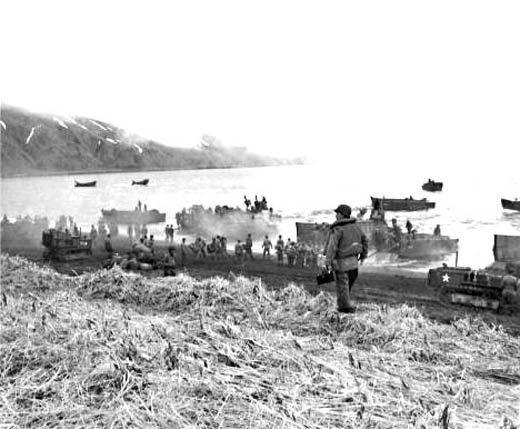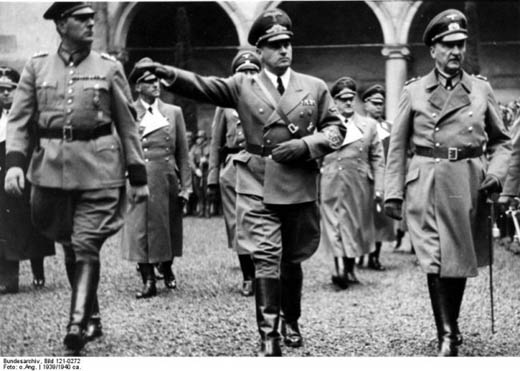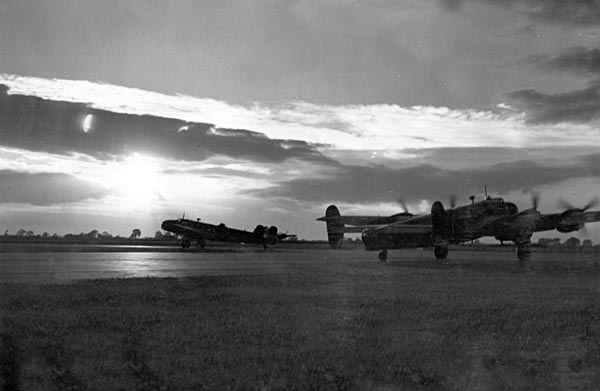Air Operations, Bismarcks
V Bomber Command B-17s and B-24s attack the Vunakanau airfield at Rabaul while other B-24s mount individual attacks against the Rapopo airfield at Rabaul.
[Air Operations, Europe
RAF BOMBER COMMANDEvening Ops:
- 290 aircraft, including 181 Halifaxes, 107 Stirlings and 2 Lancasters, are sent to bomb the Schneider armaments factory and the Breuil steelworks at Le Creusot.
- The plan calls for the Pathfinders to drop only flares and the Main Force would identify their targets by the light of these flares. The Main Force is to make 2 runs over the target dropping a short stick of bombs between 5,000 and 10,000 feet on each run. At this stage of the war, the bomber crews are used to bombing target indicators and many have difficulty identifying their targets. Lingering smoke from the large number of flares used is blamed for most of the difficulty. Bombing photographs show that all crews drop their bombs within 3 miles of the target, but only about one fifth actually hit the factories. Many bombs fall on nearby residential properties. There are no details from the ground as to the extent of the casualties.
- 2 Halifaxes are lost.
|
|
- 26 of the H2S-equipped Pathfinders are to fly on to drop flares over the electrical transformer station at Montchanin. By the light of these flares 26 more Lancasters from No. 8 Group are to attack this second target. Most of the crews, however, mistake a small metal factory for the transformer station and bomb it instead. A few crews do correctly identify the station, but there are no direct hits.
- 6 Mosquitos are sent to Colgone, Duisburg and Düsseldorf, and 12 Lancasters of No. 3 Group lay mines in the Gironde River.
- 1 Lancaster is lost.
ITALY:
IX Bomber Command B-24s attack ferries in the Straits of Messina, the harbor at Reggio di Calabria, and the rail yards and ferry terminal at Villa San Giovanni.
[Air Operations, Marshalls
During the night, VII Bomber Command B-24s based at Funafuti reconnoiter and photograph Jaluit Atoll.
[Air Operations, New Guinea
- 3rd Light Bomb Group A-20s attack a village and heavily damage a trail.
- B-24s mount individual attacks against Finschhafen.
Air Operations, Tunisia
A P-39 from NACAF's 350th Fighter Group downs a Ju-88 just off the coast at 0745 hours.
[Atlantic
The Italian submarine Barbarigo is sunk in the Bay of Biscay.
[ Landing Men and Supplies on Attu, June 19, 1943 |
 |
Britain, Home Front
In Horse Racing, Dorothy Paget's 'Straight Deal' wins the Derby.
[Germany, Home Front
Goebbels boasts that Berlin is now 'free of Jews'.
[Indian Ocean
The US freighter Henry Knox, en route from Fremantle, Australia to Bandar Shahpur, Iran, is torpedoed and sunk by the Japanese submarine I-37. 13 of the 42-man crew and 13 of the 25-man Armed Guard sailors are lost. The survivors eventually reach Maldives near the end of June.
[Italy, Home Front
The authorities give the populations of Naples and towns in Sicily a matter of weeks to evacuate their cities.
[ Hans Frank (center), Governor of Poland |
 |
Pacific
- The US submarine Growler (SS-215) attacks a Japanese convoy on the Palau-to-Rabaul route and sinks the army cargo ship Miyadono Maru (5196t) about 200 miles north-northwest of Mussau Island.
- The US submarine Gunnel (SS-253) damages the Japanese gunboat Hong Kong Maru and sinks the merchant cargo ship Tokiwa Maru (6971t) and the coastal minesweeper Tsubame off Shirase, Japan.
- The US submarine Sculpin (SS-191) sinks the Japanese gunboat No.1 Miyasho Maru and army cargo ship Sagami Maru off Inubozaki, Japan.

